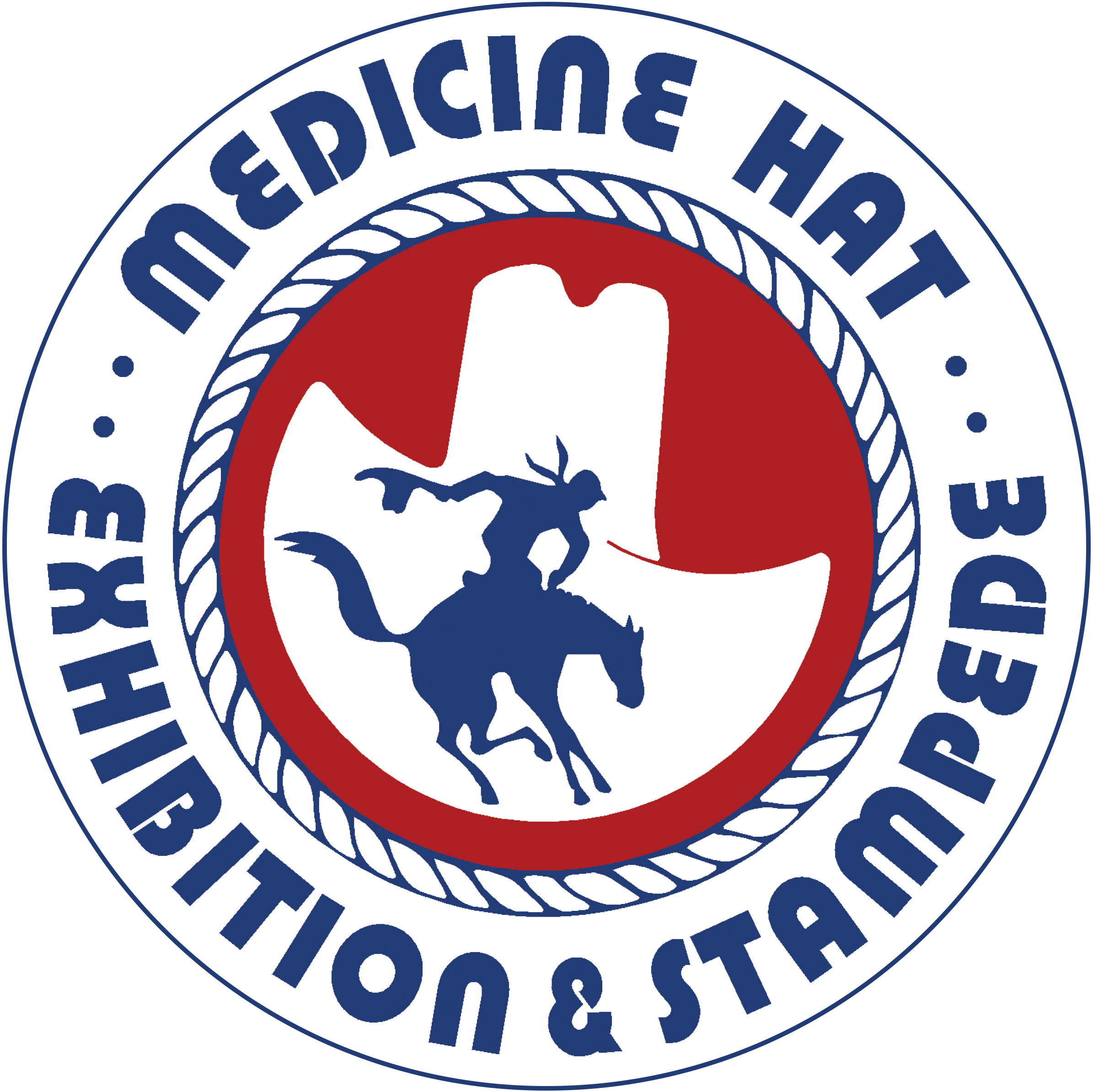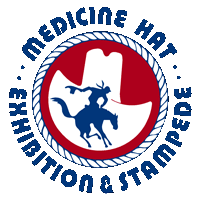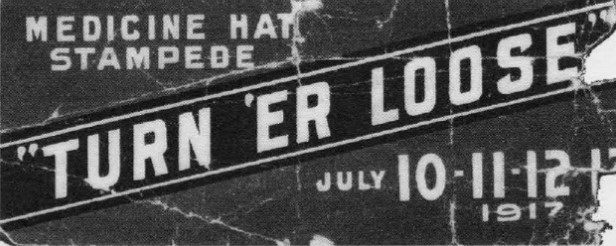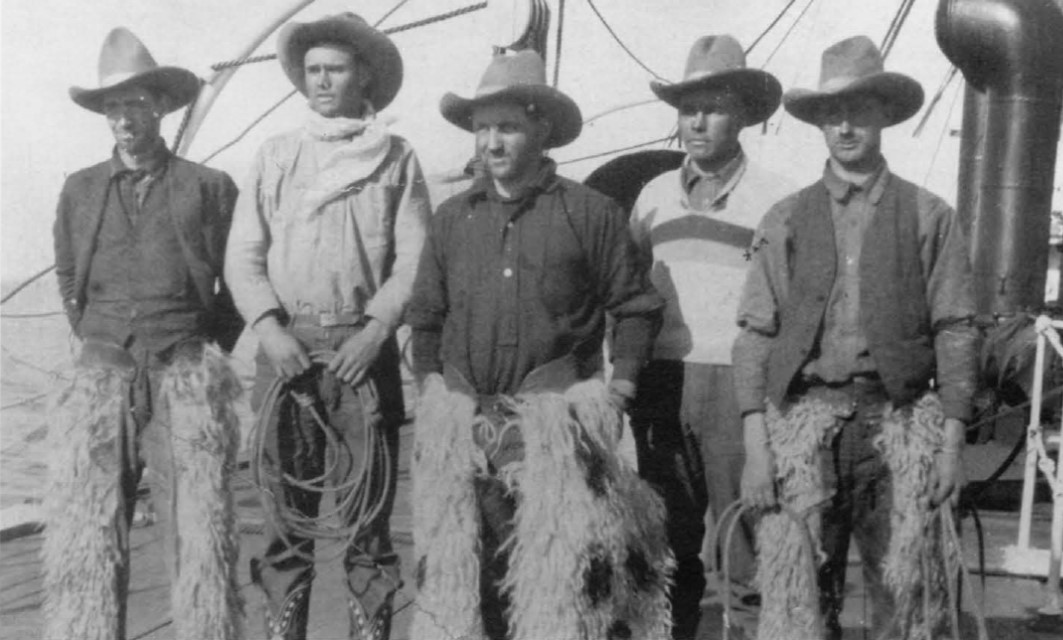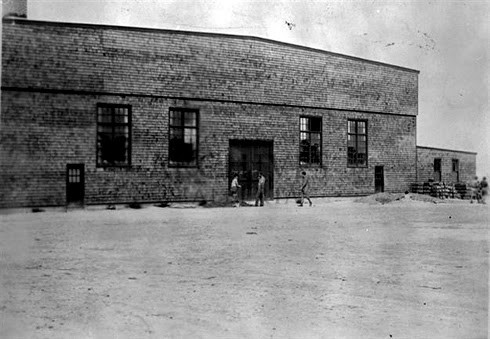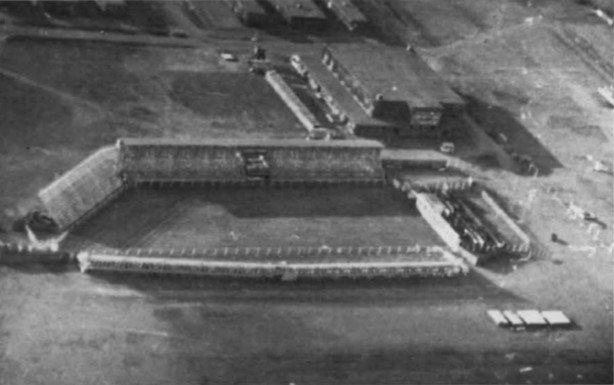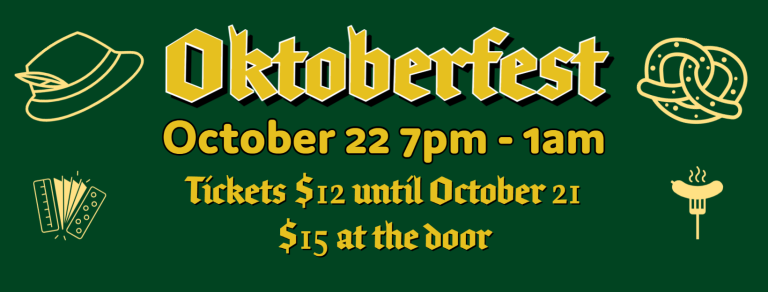History
Our Beginnings
The Medicine Hat Exhibition and Stampede Company has an impressive history and it is a story, which should be told. This is a unique asset and it is one which should be fostered, encouraged and promoted in an effective and meaningful way.
Recognizing the importance of the history of the Medicine Hat Exhibition and Stampede Company and desirous of preserving its history and creating and developing a Heritage Resource Management Strategy, the Board of Directors established a Historical and Heritage Resource Management Committee (May 2018) with its stated objective to preserve the heritage resources of the Medicine Hat Exhibition and Stampede Company and to enhance, record and preserve for posterity its rich history.
To that end, this historical portal was launched with the goal of reaching out and informing as many as possible about the unique history of the Medicine Hat Exhibition and Stampede Company and to help carry on the tradition and build and preserve a legacy for the future.
William J. Anhorn
Chairman, Historical and Heritage Resource Management Committee
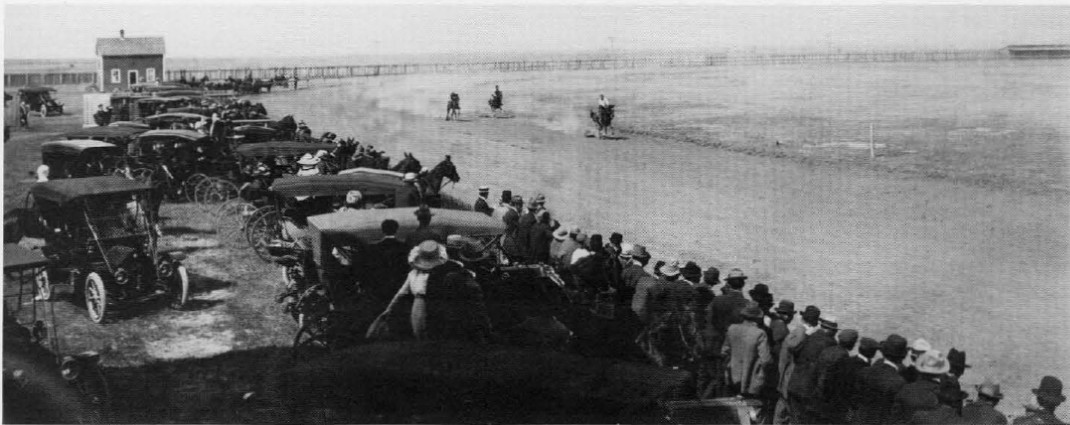
The Early Years-“A Tradition since 1887”
With the arrival of the of the Canadian Pacific Railway (CPR) in Medicine Hat in 1883, it did not take long before the area became a “hub” of activity as immigrants and early settlers arrived to use the valley of the South Saskatchewan River as a “staging” area before embarking on their new adventure and merchants arrived eager to serve their needs and the needs of the “mushrooming” ranching community that developed in the south east section of the then, District of Assiniboia, North West Territories. As the townsite was not surveyed until later in 1883, the early arrivals pitched tents in somewhat of a haphazard fashion in close proximity to a temporary train bridge, which crossed the South Saskatchewan River. As soon as the surveyors had completed their survey, “the tents were folded and the early citizens proceeded to erect stores and afterwards houses and other buildings”. (Morrow J.W, “The Early History of the Medicine Hat Country” published 1923 at p. 30)
In 1887, several merchants and ranchers from the area decided to hold an Agricultural Fair “to bring together the urban and rural residents for a few days of celebration, almost like a “thanksgiving” for the growth of the new community”(Willcocks, George “The History of Exhibitions and Stampedes in Medicine Hat” published 1996 at p. 3). The Medicine Hat Agricultural Society was formed and an executive consisting of a mixture of merchants and area ranchers was formed to spearhead the event.
The first Medicine Hat Exhibition was held on Friday and Saturday October 14 and 15, 1887 “with livestock exhibits displayed at the CPR stockyards and all other exhibits, including poultry, grains, garden vegetables, roots, field crops, fruit, baking, preserves and ladies fancy work all being displayed”. (Willcocks, p. 3) The Exhibition was a huge success in bringing the urban and rural communities together as one homogeneous group, which resulted in what was to foreshadow an annual event. This tradition continues to the present which gives rise to the current vision statement of the Medicine Hat Exhibition and Stampede Company, “A Tradition since 1887-A Legacy for the Future”.
Not unlike many organizations, the Agricultural Society went through some growing pains and there became a philosophical divide when in 1889 horse racing became a feature of the fair. Some members of the Board of the Agricultural Society felt that the annual event should be strictly an agricultural exhibition and that entertainment, particularly horse racing and “particularly this form of entertainment that encouraged gambling should not be part of the Exhibition”. (Willcocks, p. 4)
As a result, a separate entity called the Medicine Hat Turf Association was created to promote horse racing and similar activities, but there remained a close liaison between the Agricultural Society and the Turf Association, with many Board members and patrons being members of both organizations.
In 1900, “cowboy races” and “lady rider” competitions became part of the agenda for the Turf Association annual event. Steer roping followed, where local cowboys and ranch hands demonstrated their skill and competed for prize money. Breaking horses had always been a part of the ranching duties and it was not uncommon for ranch hands to get together and demonstrate their skills in a friendly unorganized competition. But it wasn’t until 1901 when the word “stampede” and “exhibition” were used together in the same context.
By 1908, a “bucking horse” competition was added to horse racing and steer roping and along with lady riding competition (which was the early forerunner of ladies barrel racing), and the modern day “rodeo” or “stampede” in Medicine Hat was born.
Necessity is the mother of invention and sometime financial difficulty becomes the catalyst. Throughout the early years, as well documented by George Willcocks, both the Agricultural Society and the Turf Association in varying degrees suffered some financial difficulty. Although the two organizations had always worked closely together, combining their events on the same dates albeit at different location, it soon became apparent that continued success required some form of amalgamation. Although there is no record of a formal amalgamation between the two entities, somtime between 1908 and 1911, the two organizations worked very closely together in promoting various types of entertainment to attract larger crowds and to become more economically viable. It was only a matter of time before they would merge as a single entity.
“The Exhibition in 1911 was the most successful Exhibition that had been held in Medicine Hat. A 1000 seat grandstand and new stables had been built. Racing was held in the evenings as well as the afternoons. It was in 1911 that entertainment, as we know it today was introduced to the Exhibition. The promotion for the 1911 Exhibition featured the following forms of entertainment, a high wire act, a palm reader(Madam Zelda), a lady who would go into a pit with an armadillo( known as the South American grave robber), an act called the Hurdy-Gurdy and Crazy Horse and Scottish Dancing by local girls”. (Willcocks, p.8)
Despite some early financial difficulties, The Agricultural Society’s Exhibition continued annually from 1887 for a total of 27 years. However, the 28th annual exhibition was interrupted with the advent of World War I, and the Exhibition grounds became a military training site for the Third Mounted Rifles as the Medicine Hat regiment prepared in order to be deployed overseas.
“Thus came the first interruption in Medicine Hat’s annual Exhibition. Fortunately, it was a short interruption and in 1917, the Exhibition continued greater than ever and for the first time it was know as the Medicine Hat Exhibition and Stampede“. (Willcocks, p.9)
Turn ‘er Loose
The 1917 Medicine Hat Exhibition and Stampede
The phrase, “Turn ‘er Loose” for those unfamiliar with a rodeo is a colloquial expression often used by a cowboy or bronc rider immediately before the bucking chute is opened or in earlier times when the horse, having being held down by other cowboys, is mounted by the cowboy and is given as a signal to “let” the horse go, in order for it to be ridden.
In early 1916, the Department of National Defense discontinued the military training of “mounted” rifle regiments, as horses no longer served a useful purpose on the battlefield. The Exhibition Grounds in Medicine Hat, which previously had been used for this type of training was abandoned, leaving behind a number of buildings including horse barns and horse stalls, which had the capacity of accommodating over 500 horses.
With the facility being available, the idea of re-establishing the annual Exhibition in 1917 was discussed openly and it became the “talk” of the Town with many prominent businessman and ranchers promoting the idea. One of the most unlikely proponents and one of the first to mention the holding of a “Stampede” in connection with the Agricultural Fair was the parish priest at St Patrick’s Church, Father O’Mara. In an uncharacteristic letter to the editor of the Medicine Hat News, he argued in an emphatic and quite convincing fashion, for the need for a Stampede in order to being people together and to celebrate. He penned the following:
“If we are going to aim at having as successful show as possible next year, why not buck up and have a Stampede as one of the features and drawing cards for the 1917 show. Why should Medicine Hat not have the very best Stampede in the West. Bear in mind that Medicine Hat invented the “Stampede” as far as the West is concerned. Pity while we were smart enough to invent the Stampede we were too slow in taking out a patent for the invention.”(Willcocks, p.10)
The passionate letter appeared to attract attention and another clergyman, The Reverend John Morrow, Minister of St. John’s Presbyterian Church, took up the cause and at a public meeting held to discuss the matter emphasized in an address to the gathering, the need or importance of having a Stampede in conjunction with the Agricultural Fair. His plea struck a responsive chord. From that time on, any reference to a competition involving cowboys and their horses in Medicine Hat was known as a “Stampede” and the use of the generic term “rodeo” fell into disfavour.
A Special Meeting was held in January 1917 with a large and enthusiastic group of citizens and a Stampede Committee was formed with the stated objective of “having the greatest Stampede in Western Canada”.
“After months of work by one of the largest volunteer groups ever assembled in Medicine Hat, Stampede week started on July 9th, 1917”. (Willcocks, p.14).
A Stampede parade and Stampede Queen contest and open-air street dances and more formal galas became part of the festivities.
“Turn ‘er Loose” became the marketing theme for the Stampede showing up on posters, banners and bumper stickers and by any standard, the first Medicine Hat Exhibition and Stampede was a tremendous success and by some accounts had put a similar event in Calgary “to shame”.
With Medicine Hat only having a population of 10,000, over 29,000 people paid to attend the four Stampede performances and its obvious success financially and otherwise proved to be the cornerstone for the current Medicine Hat Exhibition and Stampede, which continues on in similar fashion today but on a much grander scale.
The Twenties and Some Difficult Times
The Demise of the Medicine Hat Agriculture Society
Unfortunately, the success of the 1917 Medicine Hat Exhibition and Stampede was short lived, even though the Agricultural Society and applied to become a member of the Western Canada Fair Association and was given a “B” license along with Lethbridge and Moose Jaw, Saskatchewan and fair dates were given for 1918 from July 22 to July 27. Due to poor planning and some operational issues, the 1918 event was not promoted to the same degree as the previous year and some attractive features were cancelled including the Stampede parade and the Queen contest, both of which had been a huge drawing card. Perhaps, the City and the organizing committee, after the huge success of the prior year was suffering from a “stampede” hangover.
The Stampede, nonetheless was held in conjunction with the Exhibition and entertainment and a mid-way was included, all at the fair grounds. And as one might expect, the Society experienced a financial loss due to the lack of planning.
Indecision and a lack of financial resources plagued the 1919 and 1920 Exhibition, which created an inauspicious start to the Twenties. This difficulty continued through 1921-23, with an Exhibition being held in conjunction with other types of events but the Stampede itself fell by the wayside until 1924.
In that year, the British Empire Exhibition was being held in London, England and some spirited Canadian organizers decided to incorporate a World Championship Rodeo into the event to be held at the famed Wembley Stadium. A.P. Day, who had been the arena manager of the Medicine Hat Stampede in 1917 was contracted to supply the stock and organize the event and he took with him a number of local cowboys, all the way to London, England to compete in the event. The notoriety of the World Championship Rodeo under the watchful eye of King George V and Queen Elizabeth of England did not go without some controversy as a concern was raised in the House of Lords about whether the event should be allowed due to alleged potential for “cruelty to animals” which brought an interesting response from none other than the infamous Lord Denman from the House of Lords, who was recorded in the Parliament Hansard as follows:
LORD DENMAN:
“My Lords, after reading the Question which the noble Lord has put on the Paper and after listening to the speech which he has made, I am not sure whether he is a judge of horses and horsemen, but I am sure that he has discovered a mare’s nest of no usual dimensions. For my part, I confess I have never seen a Question, nor listened to a speech, so remote from the actual facts of the case. I will tell your Lordships what these rodeos or “round-ups” really are. They are competitions which are held in America, in Canada, and, not so frequently but still fairly frequently, in Australia. They are tests of skill, of courage, of strength, and of horsemanship. The horses used in these competitions are well known outlaws. They are vicious horses—so vicious that their vice has become a positive virtue—and they are kept for that purpose, and for that purpose only. The noble Lord said that inducements were offered to these bucking horses to become still more fractious. He did not say what inducements were offered. I confess I should rather like to see the noble Lord himself offering an inducement to one of these bucking horses to buck even worse than they generally do. I think the spectacle might be rather remarkable.
The cattle that are used are rounded up wild from the ranches. I submit that they undergo no more cruelty than, probably not so much cruelty, as cattle which are in the ordinary course rounded up from the plains or the ranches and despatched by rail or steamship to their destinations in other parts of the world. If there be danger in these competitions, it is to the men and women who take part in them. These men and women are not salaried performers; they are really amateurs. Part of their travelling expenses, but I believe only a part, is paid for them. Their expenses while they are here are paid by themselves. They may, if they are successful, win money prizes—at this particular round-up, money prizes of considerable value—and also cups and trophies. But I venture to say that the renown that they attain in their own country, if they are fortunate in winning these prizes, is a far greater inducement to them to take part in the competitions than any actual gain”.
This is a rather interesting and somewhat amusing description of the “rodeo” from a member of the House of Lords at the time of the World Rodeo Championship which was held in London, England 24-06-1924 during the British Empire Exhibition.
The success of the World Championship Rodeo in London, England and the participation by several Medicine Hat cowboys including Jack Furnell, Elmer Jamieson, Dick Hutchison, Art Lund and Andy Lund, brought back an excitement and an enthusiastic desire within the community to incorporate a full blown Stampede in conjunction with the Exhibition in 1924. Under the watchful eye of local ranchers James Mitchell and Henry Cavan, as arena managers, the Stampede was again a huge success at the box office.
Under the guidance of Cavan and Mitchell, successful rodeos were held in 1925 and 1926 and the union of the Exhibition and the Stampede under one “roof” seemed to be “recipe” for success. In 1925, a young cowboy named Lorne Thompson emerged as a budding star of that year’s rodeo capturing several events and as time will tell, it was a name that became synonymous with the Medicine Hat Exhibition and Stampede as he became a founding member of a new organization, which emerged in 1947.
Unfortunately again, the success was short lived and the trials and tribulations and financial difficulties continued to plague the Agricultural Society. After having exhausted its favour with City Council, who were no longer prepared to “bankroll” the organization, unless the organizers were prepared to offer their personal guarantees, the decision was made in 1929 to dissolve the Society.
The 1920’s proved to be tumultuous times and despite “having invented the Stampede in Western Canada” it was left to others for the time being to exploit its value as a spectator sport/event, most notably the Calgary Stampede. It wasn’t until 1936 that the Stampede became re-invented and was resuscitated back to life in Medicine Hat.
Rhine Hall
The Medicine Hat Stampede and Exhibition Company -1936 t0 1940
“In April 1936, the blare of Gabriel’s Trumpet finally awakened some of Medicine Hat from their Stampedeless sleep”. (Willcocks, p.23)
In 1936, Lorne Laidlaw K.C. together with some prominent businessmen and ranchers from the area again approached Medicine Hat City Council with a business proposition to re-establish the Stampede as an annual event, with the vision of holding the event on a regular basis well in to the future. The proposal involved leasing the City owned fairgrounds for a period of ten years with an option to purchase. Anxious to see the Stampede revived in the Hat, Council approved the lease on quite favorable terms and as a result a new company was created, “The Medicine Hat Stampede and Exhibition Company”.
The 1936 Stampede was scheduled as a two-day event on June 23& 24, “with full Stampedes in the afternoon, and now that there was street lighting at the fairgrounds, entertainment and dancing in the evenings.” (Willcocks, p.23) Alberta Premier William Aberhardt opened the Stampede and over the two-day event over 6,000 fans came out to enjoy the rodeo entertainment. Famous rodeo cowboys like Pat Burton, Carl Lund, Herman Linder, Warner Linder and Lorne Thompson all participated, making it a world-class event.
The 1937 and 1938 editions of the Stampede continued to be a successful happening, attracting competitors from around the world. As sign of things to come, professional cowboys Cecil Bedford and Jack Wade, fresh from competing in Australia, flew a plane from Washington in the U.S., where they had been competing, to Medicine Hat in order to arrive in time to compete in their scheduled events at the 1938 Medicine Hat Stampede.
Despite the tremendous success of the Stampede and its growing popularity, the Board of Directors decided not to hold the event in 1939. Two factors contributed to the decision. Firstly, war clouds loomed in Europe and there was the constant fear that another World War would erupt at any moment. Furthermore, plans had been made for King George V and Queen Elizabeth to travel across Canada in 1939 with a scheduled stop in Medicine Hat. Considerable planning had taken place for this stop over and it was considered too much of a task to organize two celebrations in one year. The premonition about a possible war came true as in September 1939, when Canada along with Great Britain and other members of the commonwealth declared a state of war against Germany and Italy.
And just like in previous times, the fairgrounds played an important role in the war effort, just as it had in World War I. The lands were purchased by the Government of Canada, as well as some surrounding farmland and the site became the home of the British Commonwealth Service Flying Training School#34.
“Like its predecessor, the Medicine Hat Agricultural Society, the Medicine Hat Stampede and Exhibition Company was forced to dissolve and once again, Medicine Hat was not only without an Exhibition and Stampede but the City was without a fairgrounds for the balance of the Second World War.” (Willcocks, p.25)
Yet again, Medicine Hat fell into a “Stampedeless sleep”.
But the slumber was short lived and once awakened was renewed with great vigour.
Grandstands 1950
MHE&S: The First Ten Years- 1947 to 1956
“This was a decade of planning, building, expanding and experimenting that saw the newly formed Medicine Hat Exhibition and Stampede grow from a two day event with no capital assets and a budget of 20,000 to a three day fair with capital assets in 1956 exceeding $60,000 and an annual budget of $20,000.” (Willcocks, p. 31)
The Medicine Hat Exhibition and Stampede Company was officially incorporated on May 8, 1947 and the elected officers and directors were a combination of well-known businessmen and ranchers, who together brought a unique perspective to the organization. This unique business model continues today as an effective and highly marketable “union” between urban and rural, which appears to be a true hallmark of success and reinforces the original purpose or goal of the Exhibition and Stampede in bringing people together in celebration of its unique past and remarkable history.
Those who had the courage and foresight to carry on the “Tradition since 1887” included the following:
- Honorary President: Senator Fred W. Gersh
- President: Mack Higden
- First vice President: Dirk Scholten
- Second Vice President: Eugene Burton
- Managing Director: Lorne Thompson
- Secretary: Joseph P Marsh
- Treasurer: H.R. Hutchison
The Directors of the newly “minted” company included:
Arthur P Burns Hargrave Mitchell S.F Scott
Henry Cavan Emerson Porter Dr. Ted Slack
Rueben Gardner James W Robinson Chick Taylor
W.S. Gray Charlie Ronan Percy Yeo
The POW camp and its ancillary buildings became focal point of the Stampede grounds including, in particular, the prisoners’ drill hall, which became main exhibition hall. A 3,000 seat bleacher, corrals, holding pens and chutes in order to a accommodate the Stampede were all constructed in short order, which was quite an accomplishment.
The 1947 inaugural “new’ Stampede was a huge financial success and the commitment and drive of the officers and directors of the MHE&S, who were collectively the “who’s who” of Medicine Hat were rewarded by the City committing to the organization a 25 year lease at the annual rent of one Canadian dollar.
Efforts were made to provide greater and different forms of entertainment in order to attract bigger and larger crowds and a midway with rides and games became a mainstay of the event and a permanent fixture. The Annual Stampede parade was reintroduced along with the Stampede Queen contest. But it was the Stampede, which became the main attraction, and which continues to the present to be the featured event and rightfully so.
As the Stampede grew, the need for volunteers grew exponentially and with a view to attracting more dedicated volunteers, a special class of director or “associate director” was created in 1950. This experiment became hugely successful and laid the foundation for a truly volunteer based organization, which continues to this day to be a distinguishing hallmark of the MHE&S. This aspect combined with its continued strong community support has made a significant contribution to its overwhelming success as a “non-profit community organization dedicated to carrying on the Western traditions of range and social life”.
An excerpt from an editorial found in the Medicine Hat News summed up the first decade of the Medicine Hat Exhibition and Stampede in an eloquent way,
“The Stampede organization has enjoyed very fine community support and it has been blessed with a progressive and dedicated leadership. A small band of pioneers interested in reactivating this great show has brought into being and built a healthy financial and physical foundation for the future. The men at the head of this organization have done a mighty fine job.” (Willcocks, p. 35)
And as Lord Denman might say, “HERE..HERE!”
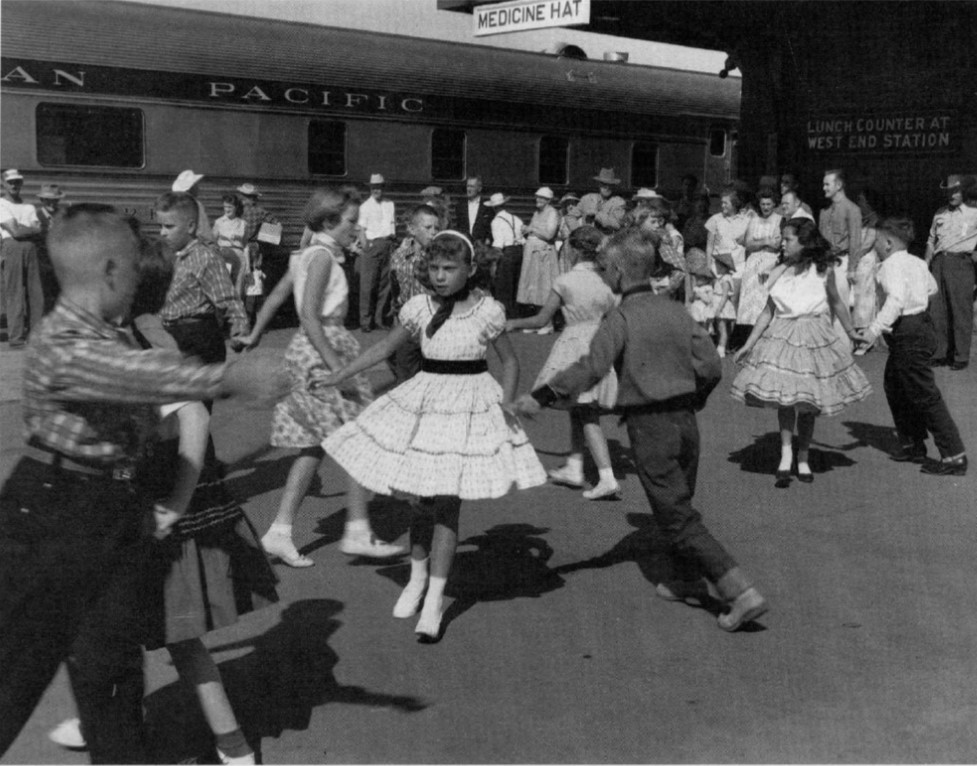
The Second Decade of the MHE&S 1957-1966
The next decade of the history of the Medicine Hat Exhibition and Stampede Company centered on the continued expansion of facilities and the improvement of management practices. With the Stampede continuing to be the centerpiece of the enterprise, it was quickly determined that there was a need to increase the capacity of the grandstand and to improve the quality of the “bucking” chutes and this became an early priority. The carnival or mid-way continued to be an important attraction and steps were taken to improve this area. All of these improvements became part of an overall master plan and were completed by 1966. The new grandstand was a welcomed addition and again contributed to the Stampede’s reputation as being a world-class event, attracting professional cowboys from around the world, all of them eager to compete as part of the rodeo circuit across North America.
Like most organizations, which undergo a period of rapid growth, the management practices must be evaluated and reassessed to ensure that they continue to be relevant. It is simply good business to conduct such a review.
A special committee was appointed in 1962 to review the management practices since the time company was established and to make recommendations regarding any changes in both the “governance” and “management” of the Stampede Company. William Flett, the then Regional Superintendent of the Canadian Pacific Railway in Medicine Hat and a Shareholder and Director was appointed to Chair the committee.
The written recommendations for change prepared by the Committee was “affectionately” referred to as the “Flett” report and it was not without some controversy as documented by George Willcocks in his book.
The report included some important recommendations including the creation of an executive Committee to be responsible for the operations of the Stampede on a year round basis and the appointment of a “paid” full-time manager. It was the latter recommendation, which caused some controversy. Up until that time, all of the organization of the Stampede was done strictly on a volunteer basis and the idea of a “paid” position did not sit well with some “purists”. All of the recommendations were approved at the annual meeting except for the recommendation for the hiring of a paid manager, which strangely, was simply tabled.
Inexplicably, the issue was short lived as within a few months Dirk Scholten was appointed the first paid manager of the Medicine Hat Exhibition and Stampede Company, a name that also over time became synonymous with the event.
Dirk Scholten had been associated with the Medicine Hat Exhibition and Stampede Company long before being “hired” as the first paid manager. He had been the one approached by Hector Lang, Mayor of Medicine Hat about reviving the Stampede as an annual event in 1946, even though Scholten had no prior experience organizing a rodeo. He was better known for leadership skills as he rose through the ranks in World War II becoming a colonel with the Royal Canadian Electrical and Mechanical Engineers Corps, having received an engineering degree before immigrating to Canada from his native Holland. With his military background and organizational skills, he was able to “recruit” a strong core of local successful businessmen and accomplished ranchers in order to get the job done. He took charge of every aspect of the operational side of things as general manager in advance of the 1947 Stampede and the following year was elected as first vice president in 1948. He continued thereafter to be the “unpaid” general manger of the Medicine Hat Exhibition and Stampede for another 15 years, before the issuance of the infamous Flett report.
He continued in his capacity as general manager of the Medicine Hat Exhibition and Stampede until he retired in 1975. It is no wonder than he was honored by the Canadian Rodeo Cowboys Association just prior to his retirement with the a special plague engraved “To Mr. Medicine Hat Stampede for his outstanding contribution to the to the sport of rodeo”. He was subsequently honored by the organization for which he had devoted the better part of his life, when the Board of Directors of the Medicine Hat Exhibition and Stampede Company bestowed it’s highest honor when they appointed him a Life Director.
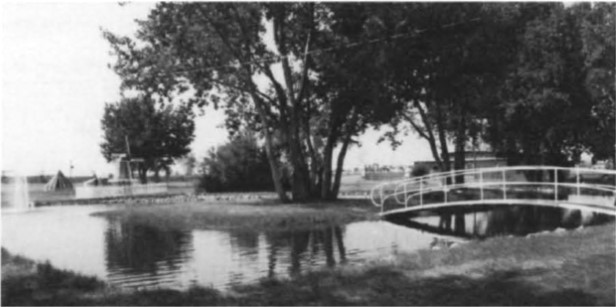
Pioneer Village
The Third Decade of the MHE&S-1967-1976
Continued growth and expansion of facilities at the Stampede grounds marked the next decade of progress at the Medicine Hat Exhibition and Stampede Company, aided largely by monetary grants made available to non-profit organizations by the Government of the Province of Alberta. Grants made available to fairs and exhibitions were based upon a certain classification system, which in turn determined the amount of prize money available for agricultural exhibits. In 1969, Medicine Hat was given an “A” rating, the first fair in Canada to receive such a designation since 1945, (Willcocks, p.37). This recognition not only boosted its status but also increased the Stampede’s eligibility for larger Provincial grants, which in turn enhanced its ability to undertake a planned capital expenditure expansion program.
One of the proposed capital expenditures involved establishing a farming display area in a park like setting with the intention of demonstrating and reinforcing the agricultural “roots” of the organization. The area was initially known as the Agricultural Arcade, and provided a welcomed “oasis” within the fairgrounds. The idea of celebrating our agricultural and rural heritage gained strategic importance and was the forerunner of what is currently known as “Pioneer Village”, an impressive collection turn of the century buildings which take the “visitors” back in time, and is a popular attraction.
Demands for more exhibition space and the need for a more spacious and permanent area to house the corporate offices of the Medicine Hat Exhibition and Stampede, resulted in a rather ambitious project which was proposed to be built in partnership with the Kinsmen Club of Medicine Hat. The idea was to build an arena complex, which would have a full year round skating facility, which could be used on a limited basis during the Stampede as an exhibit hall and an adjacent attached ancillary building, which would be used as office space and corporate headquarters. The Kinplex was built with a significant contribution by the local service club, the City of Medicine Hat and the Medicine Hat Exhibition and Stampede Company and was a crowning achievement and continues to be an integral part of the Medicine Hat Exhibition and Stampede facilities.
Mr. Medicine Hat Stampede, Dirk Scholten retired as general manager after 29 years of service to the community and the Stampede Company and his successor was Ralph Murray, who in time, not unlike his predecessor, became a name that was synonymous with the sport of rodeo in Canada.
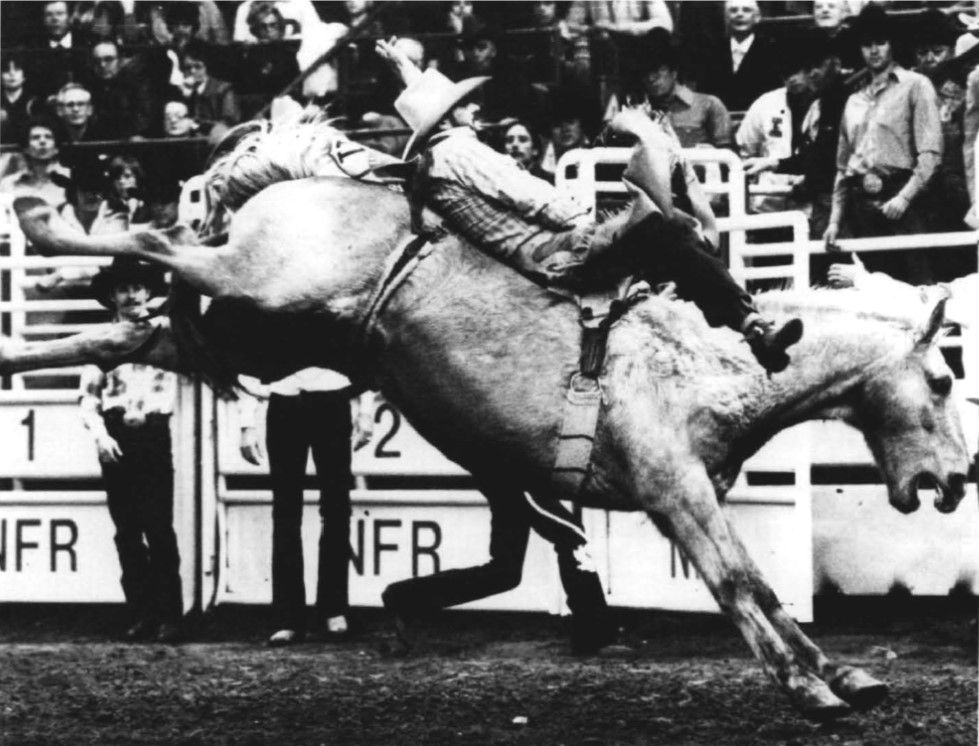
The Fourth Decade Medicine Hat Exhibition and Stampede-1977-1986
The construction of an all purpose building with a theatre area, kitchen and banquet facilities came up on the drawing board in 1978 and not unlike the Kinplex was a rather ambitious project, requiring all of the human and financial resources that the organization could muster. Approved in principle in 1979, the project became a reality on July 16th, 1981 when “the Cypress Centre” was officially opened. This year round all-purpose facility, which has become a featured cornerstone to the Stampede grounds, was dedicated to Lorne Thompson, a 1947 founding member and past president and who was driving force behind its development and construction. Mr. Thompson was an old time rodeo cowboy who proudly called Medicine Hat his home and who, as early as 1927, had competed in many rodeos right across Canada. He even starred in a Wild West show, where legend has it, that he earned his $15 dollar a week paycheck by riding up to 10 “broncs” per day in order to entertain the enthusiastic eastern crowds.
The dedication plaque honoring Lorne Thompson reads as follows:
“In recognition of his efforts in the community and especially his contributions to our Exhibition and Stampede.” (Willcocks, p. 39)
In addition to the Cypress Centre, a new 2500 seat grandstand was constructed along with a new livestock building, which was also dedicated to a long time supporter and director, Jack Anderson.
The growth and development of the Medicine Hat Exhibition and Stampede did not go unnoticed by those within the industry, when in 1980, the Canadian Association of Exhibitions, awarded Medicine Hat, in recognition of it being one of the finest fairs in Canada“The Regional Fair of the Year Award”.
The dedication and commitment of so many volunteers was properly recognized and was a fitting acknowledgement of its ambitious effort and its tremendous success as a non-profit volunteer based organization, which for decades so proudly “show-cased ” the Stampede and the many facets of the agricultural exhibition.
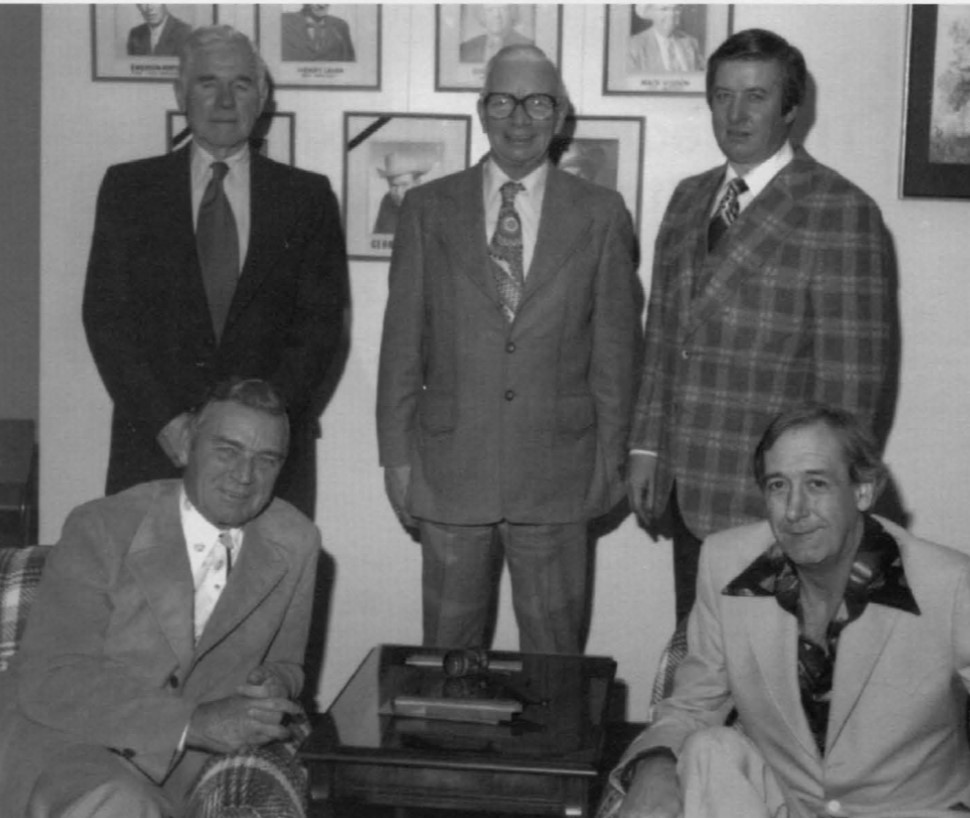
Past Presidents 1978
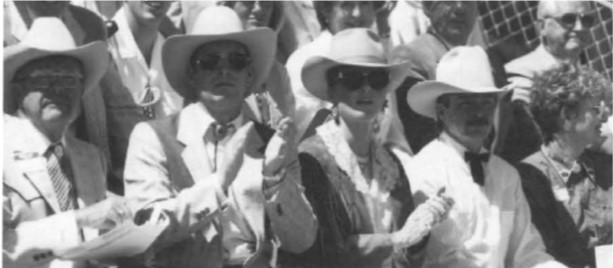
Duke & Dutchess 1987
The Fifth Decade-1987-1996 “The Golden Anniversary”
“Foresight” and “sustainability” are the words that come to mind in describing the period 1987 to 1996 in relation to the history of the Medicine Hat Exhibition and Stampede Company. A business model that allowed for multi-faceted activity on a year round basis as opposed to only a one week per year Stampede seemed to be an important first step towards long term financial stability and “sustainability” became an important component of the dialogue around the Board table. Those with the foresight to recognize this as an important business model realized the need to develop a program not only to enhance the existing amenities but also to expand and develop new facilities to accommodate this new “vision” for the future.
“To achieve this goal, the Board approved more than a million dollars in renovation improvements to the Company’s facilities. A very fine air-conditioned banquet room, seating 275 people for dinner, was built under the grandstand and all the meeting rooms in the Cypress Centre were modernized and redecorated. A six hundred thousand dollar kitchen was added to the Cypress Centre to provide full dinner preparation to serve banquets capable of seating 750 diners”.
(Willcocks, p. 40)
These new facilities created a new and important public venue, which would be capable of hosting a variety of different larger events and occasions and other unique events organized and developed by the Company itself. This allowed the organization to become a full year round operation utilizing all the fairgrounds and facilities in an efficient, effective and profitable manner.
Administratively, Dan Sodero succeeded Jim MacArthur as general manager as he decided to pursue his education. Under Dan’s leadership, the concept of full utilization of Company facilities on a year round basis became a reality and the vision for a bright future seemed to be well within grasp.
In 1997, The Medicine Hat Exhibition and Stampede Company celebrated its Golden Anniversary of 50 years of continuous operation and excellent service to the both the rural and urban community of Medicine Hat and the surrounding area. In 1947, the founders of the Medicine Hat Exhibition and Stampede Company had a vision for the future, but few would have imagined that the that “vision for the future ” would evolve into year round enterprise with the Stampede being the important centerpiece, and as predicted long ago, “one of the Best Stampedes in Western Canada” attracting and entertaining guests from around the world. Their vision continues to resonate today just as much as it did back then and it is appropriate that this success continue to be celebrated.
The foresight and leadership of so many dedicated volunteers again marked another decade of remarkable success and seemed to herald many more good years ahead for the Medicine Hat Exhibition and Stampede Company as it entered the new millennium.
During the five decades of continuous operation, nineteen men served as President of the Medicine Hat Exhibition and Stampede Company and their vision, fortitude and commitment in the face of much adversity and many obstacles needs to be acknowledged and recognized as we move into the next chapter of this history book.
These remarkable citizens, whose contributions were truly valued include:
- Mack Higdon- 1947-1961
- Henry D. Cavan- 1962 & 1963
- Eugene Burton- 1964 & 1965
- Rueben Gardner- 1966 & 1967
- Joseph H Fisher- 1968 & 1969
- Charles F. Beny- 1970 & 1971
- Lorne Thompson- 1972
- Rod Carry- 1973 & 1974
- George Fisher- 1975-1976
- Robert H Porter- 1977 & 1978
- Orville Kope- 1979 & 1980
- George Renner- 1981 & 1982
- William A Palmer- 1983 & 1984
- George Maser- 1985 & 1986
- William J Morrison- 1987 & 1988
- Alex Clarke- 1991 & 1992
- Edward Taylor- 1993 & 1994
- Robert Fisher- 1995 & 1996
Postscript
Those who, like myself were fortunate enough to grow up during this era will recognize these names as the venerable Who’s Who of the business and ranching community of Medicine Hat and surrounding area. I had the distinct privilege of knowing many of them personally and can attest to their leadership, dedication and commitment to the organization, which they would today be justly proud.
William J. Anhorn
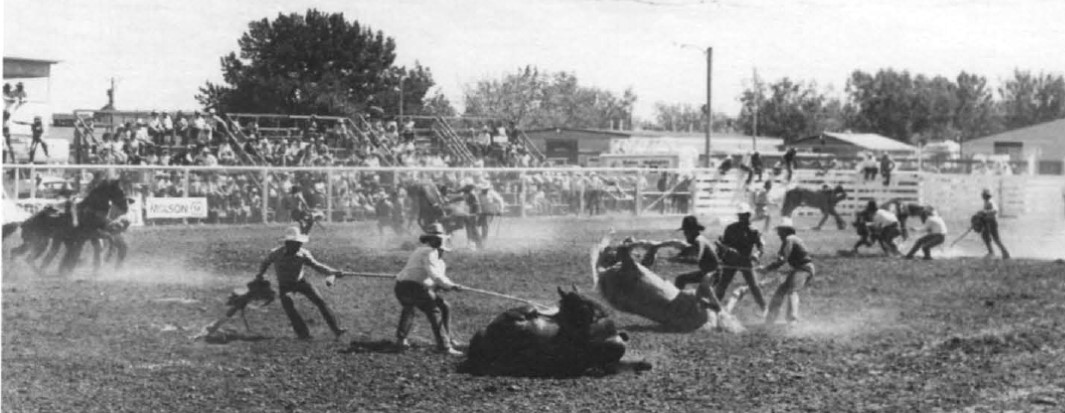
The History of the Rodeo or Stampede
A common practice among modern day ranching is the annual spring round-up, where cattle that have been out on the range are gathered up, counted and inspected and the annual crop of new calves are branded, inoculated and ear tagged, and for some unfortunate poor souls “castrated”. The “Branding Party” has on many ranches become an annual event, where in addition to doing the practical job of “branding” cattle, a celebration takes place, often involving a mixture of urban and rural “folks”.
In Western Canada, this has been a tradition that has carried on in the ranching community for decades. In earlier times, ranch hands or “cowboys” would often take pride in their skills as horsemen and cattle handlers, as riding horses and roping cattle was a common part not only of the “round-up” but of everyday ranching life. The annual “round-up” often brought together cowboys from different locations, all offering a helping hand to their neigbour. It was not unusual for them, after the hard work was done, as part of their collective competitive spirit, to create “games” for their amusement, which naturally involved using the skills that they had acquired and practised daily, which typically involved three elements or combinations thereof, “horses, ropes and cattle”.
The Origins of the Word “Rodeo”
Rodeo is derived from the Spanish verb “rodear”, meaning, “to go around and around” or the Latin term “rotare”, meaning, “to turn” and was typically used in the context of the annual gathering of livestock or “round-up”. This typically involved a cowboy roping a steer around the horns while on horseback and pulling tightly, ‘turning the animal’ while another cowboy on horseback would rope the hind legs. Once “lassoed” in this manner, the steer was held tight and others on foot would “brand” the animal.
As one might expect, the “round-up” often gave rise to an impromptu friendly competition among the cowboys, which was quite entertaining for all the spectators in attendance. The entertainment value was not lost and it did not take long before several enterprising entrepreneurs recognized this as a golden opportunity and organized a “Wild West Show”. The mystique and popularity of this type of entertainment later, gave rise to the “rodeo” as a form of spectator sport.
The modern day “rodeo” or “stampede” was born, with all the dynamics of the “round-up” presented in the form of a highly organized cowboy competition. This includes bronc riding, bull riding, steer wrestling, calf roping, women’s barrel racing and more recent adaptations of the “Wild West”, which capitalized on their intrinsic entertainment value, such as wild-cow milking, wild horse racing, chuck wagon racing and team roping. Team roping is a modern day adaptation of the roping skills and team work of the typical “round-up” and is a popular timed event at most rodeos.
The First Organized Rodeo or Stampede
It is reported that the first “rodeo” in any organized manner as a spectator sport was held in Raymond Alberta, in 1903. [1]
George Willcocks in his book, “A History of Exhibitions and Stampedes in Medicine Hat” would likely dispute this account as he made the following observation in his book.
“The first record of a commercial Stampede in Western Canada was held in Medicine Hat in 1901 which was organized and managed by a well known local cowboy and rancher, Darias Allen”. (Willcocks, p. 40)
In 1908, former American cowpuncher Guy Weadick, who had been responsible in promoting Wild West Shows in Canada and the United States took his idea for this type of entertainment to a new level, by promoting the idea of an annual frontier day celebration or “pioneer reunion” which involved a cowboy competition for World Championship titles in Calgary, Alberta.
With help from local politicians and businessmen, Weadick amassed over $100,000 in support for the first Calgary Stampede in 1912. It was a 6-day pageant and rodeo attracting more than 40,000 spectators a day, as well as legendary cowboys of the day from around the world in pursuit of $20,000 in prizes and coveted world titles.
WWI stalled the momentum of this rodeo competition, but the Victory Stampede at Calgary (1919) revived cowboy contests in Canada. In 1923, the “rodeo” combined with an exhibition, became an international event in Calgary, attracting competitors from around the world and since that time has become a permanent fixture. The annual event held in the first part of July has now become an attraction known around the world, and is more commonly simply known as the “Calgary Stampede”.
The Medicine Hat Exhibition and Stampede
From as early as 1887, the Medicine Hat Agricultural Society had included as part of its Exhibition, elements of the modern day “rodeo” with horse racing and steer roping competitions and other similar type of events being held.
“In the early days, these cowboy events held at fairs were usually referred to as “Stampedes” and it wasn’t until 1915 that these cowboy events were referred to as “rodeos” (Willcocks, p.41)
These cowboy contests were incorporated into the Medicine Hat Exhibition in 1904 and 1905, organized under the direction of a local rancher, A.P Day as arena manager and livestock provider. In 1907, a “bucking ” contest or bronc riding event was added as a featured event. In 1908, a cowboy relay race was made part of the entertainment in conjunction with the Exhibition.
Following the 1910 event, Day sold all of his “bucking” stock and as a result of that fact and the lack of an experienced arena manager being available, the cowboy event fell by the wayside.
This “hiatus” in the Hat, much to the chagrin of many locals, allowed Guy Weadick and the now famous Calgary Stampede to become an annual event in the City of Calgary and the popularity of the “rodeo” or “Stampede” as a spectator sport or event was memorialized forever.
Not to be outdone by their success, Medicine Hat came back in a “big” way with its own version of the Stampede with the “Turn ‘er Loose” Stampede in 1917 and as they say “the rest is history”. (Willcocks, “Rodeos” Chapter, p.41)
The Modern Day Rodeo or Stampede
Rodeo’s popularity sparked the growth of rodeo organizations in the 1930s, including the formation of the National Professional Rodeo Cowboys’ Association in the United States and the Canadian Rodeo Cowboys’ Association in Canada.
Despite periodic incursions to try to rearrange rodeo competitions along team sport lines, the current modern day rodeo or Stampede has remained true to its “roots” by maintaining the basic time honoured premise of individual human strength and “cowboy” skills like riding and roping matched against the animal and in some circumstances an added dimension, the “clock”. All of which makes for an entertaining afternoon of rodeo action!
Here are the type of events or contests you might expect at the Medicine Hat Exhibition and Stampede:
Bull Riding
Bull riding, pitting a rider’s balance and stability against a one-ton Brahma bull’s instinct to remove the cowboy from its back, officially entered rodeo competition in 1921.
Saddle-bronc Riding
Saddle-bronc riding dates back to a time when the livelihood of most working cowboys involved bronco-busting or taming a wild unbroken horse to be ridden.
Bareback Riding
Bareback riding began as a sideshow in rodeo, when younger cowboys earned mount money in exhibition rides aboard particularly ornery unbroken horses; the 1950s saw bareback riding gain the legitimacy of the other two riding events.
Calf Roping
Calf roping is one rodeo event still practised on the ranch, but in the artificial setting of the rodeo arena it reaches near perfection; when a barrier in front of a horse and rider is released by a bolting calf, the contestant runs down the calf, throws it to the ground and ties any 3 feet; fastest time wins.
Steer Wrestling
The other timed rodeo event, steer wrestling (originally known as bulldogging), moved from the Wild West shows to the first rodeos as a cowboy’s test of strength in bringing down a running steer by leaping from a moving horse, locking onto the steer’s horns and twisting it to the ground; Believe it or not in the earliest rodeos, the bulldogger had to finish the manoeuvre by taking the steer’s lower lip in his own teeth. Fortunately, this element has been removed from the competition.
Women’s Barrel Racing
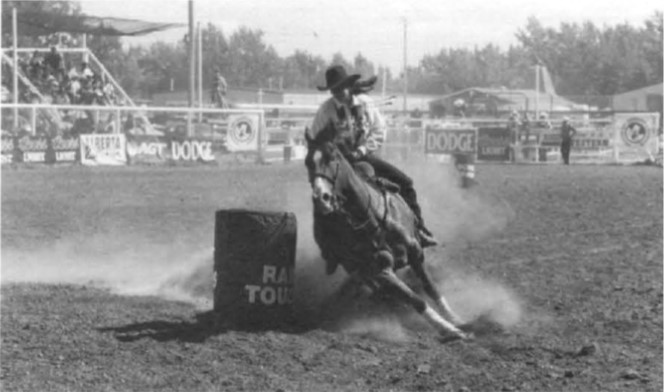
Cowgirls Competing in the 1924 World Championship Rodeo in Wembley Stadium, London, England
Women have always competed in “rodeo” events and women’s barrel racing has become a modern day attraction with “cowgirls” racing their specially trained horse around three strategically placed barrels in the arena or infield. It is a timed event, with the fastest time being the winner.
World Champions Visit Medicine Hat
While world championship titles in early rodeo were usually awarded to the winners of year-end competitions, such as the Pendleton Roundup in Oregon, the Cheyenne Frontier Days in Wyoming or the Calgary Stampede, world championships are currently determined by a cowboy’s prize money accumulation at season’s end which typically involves two major events, the National Finals Rodeo (NFR) in the U.S. (Las Vegas) and the Canadian Finals Rodeo (CFR) in various locations in Western Canada.
Among Canadians who have achieved international success as well known name recognition as world champions in rodeo are Pete Knight (Crossfield, Alta), 4-time saddle bronc champ between 1932 and 1936; Nate Waldrum (Strathmore, Alta), bareback champ in 1933; Carl Olson (Calgary, Alta), saddle bronc champ in 1947; Marty Wood (Bowness, Alta), saddle bronc champ in 1958, 1964 and 1966; Winston Bruce (Calgary, Alta), saddle bronc champ in 1961; Kenny McLean (Okanagan Falls, BC), saddle bronc champ in 1962; Mel Hyland (Surrey, BC), saddle bronc champ in 1972; Jim Gladstone (Cardston, Alta), calf roping champ in 1977; Cody Snyder (Redcliff, Alta), first Canadian to win the world bull-riding championship in 1983; Mark Roy, Canada’s first steer wrestling champ in 1992; Blaine Pederson (Amisk, Alta), steer wrestling champ 1994; and Daryl Mills (Pink Mountain, BC), bull-riding champ in 1994.
All of these world-class cowboys have competed at the Medicine Hat Exhibition and Stampede over the years.
The Medicine Hat Exhibition and Stampede continues to be one of the premium events along the professional rodeo cowboy circuit and you can expect to see past, current and future world champions compete, as they try to “earn” prize money to get them back or into the World Championship Finals.
The “rodeo” continues to grow in popularity as a spectator sport and there is no finer example of a world class rodeo than the annual Medicine Hat Exhibition and Stampede. So if the opportunity presents itself, put on some boots, blue jeans and a cowboy shirt and hat and get ready to enjoy an afternoon of rodeo action in Medicine Hat!
You will be glad you did.
William J. Anhorn
